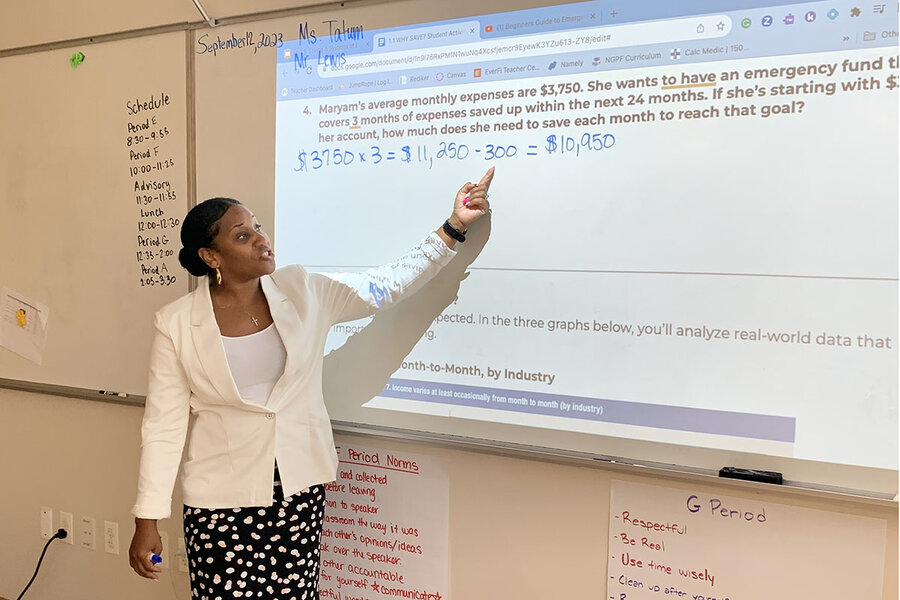Dollars and sense: Can financial literacy help students learn math?
Loading...
| Washington
In Washington, D.C., teacher Tonica Tatum-Gormes asks students to calculate how much someone would need to save to create an emergency fund covering three months’ worth of expenses.
At her nudging, the high schoolers piece together an equation. It’s early in the school year, but for students, the value of the dollar is already becoming apparent.
Why We Wrote This
A story focused onWhere does financial literacy fit into efforts to make math education more practical and equitable? An increasing number of U.S. states are mandating such knowledge for high school graduates, offering them more access to tools to help with life choices. This story is part of The Math Problem, the latest project from the newsrooms of the Education Reporting Collaborative.
The exercise is part of a yearlong course called Advanced Algebra with Financial Applications. The elective math class has been a mainstay in Capital City Public Charter School’s offerings for more than a decade, giving students a foundation in money management while they hone related math skills.
The charter school may be a front-runner in providing financial education, but in recent years, many others have followed suit – often spurred by state-level decisions. Since 2020, nine U.S. states have adopted laws or policies requiring personal finance education before students graduate from high school. This brings the total number to 30 states, according to the Council for Economic Education.
Bryan Martinez, who’s one of nine children, says he signed up for the course at Capital City because he watched his parents struggle to make ends meet.
“I just want to prepare myself for the things that are coming toward me,” he says.
Inside a high school classroom, Bryan Martinez quickly jots down several purchases that would require a short-term savings plan: shoes, phone, headphones, clothes, and food.
His medium-term financial goals take a little more thought, but he settles on a car – he doesn’t have one yet – and vacations. Peering way into his future, the 18-year-old also imagines saving money to buy a house, start his own business, retire, and perhaps provide any children with a college fund.
Bryan’s buddy next to him writes a different long-term goal: Buy a private jet.
Why We Wrote This
A story focused onWhere does financial literacy fit into efforts to make math education more practical and equitable? An increasing number of U.S. states are mandating such knowledge for high school graduates, offering them more access to tools to help with life choices. This story is part of The Math Problem, the latest project from the newsrooms of the Education Reporting Collaborative.
“You have to be a millionaire to save up for that,” Bryan says with a chuckle.
Call it a reality check or an introduction to a critical life skill, this exercise occurred in a yearlong course called Advanced Algebra with Financial Applications. The elective math class has been a mainstay in Capital City Public Charter School’s offerings for more than a decade, giving students a foundation in money management while they hone related math skills. Conversations about credit, investments, and loans, for instance, intersect with lessons on compound interest, matrices, and exponential equations.
But do topics like high interest rates translate to higher interest among students? Tonica Tatum-Gormes, who teaches the course, says yes. She attributes better student engagement to them seeing the connection between math and their future financial well-being.
Students begin to understand that “yes, I need to learn decimals, and I need to learn fractions, and I need to learn percentages because I have to manage my money and I have to take out a loan. I should understand what I’m reading before I sign,” says Ms. Tatum-Gormes.
The Washington, D.C., charter school may be a front-runner in providing financial education, but in recent years, many others have followed suit – often spurred by state-level decisions. Since 2020, nine U.S. states have adopted laws or policies requiring personal finance education before students graduate from high school, bringing the total number to 30 states, according to the Council for Economic Education.
Twenty-three states require personal finance as at least a stand-alone semester course, says Tim Ranzetta, co-founder of Next Gen Personal Finance, which tracks state-level developments. The nonprofit offers lessons and resources, and advocates for financial literacy education. The upshot is that nearly 50% of students in public high schools in the United States will receive this type of instruction through a dedicated course.
The surge comes as educators are scrambling to bolster students’ math skills, which plummeted during the pandemic and haven’t fully recovered. At the same time, math anxiety or a general dislike for the number-focused subject remains an obstacle among young people.
Advocates say personal finance courses could, quite literally, pay dividends if students learn how to make wiser money decisions and avoid financial hazards. In the process, they may also develop an interest in math because of its practical applications.
“I think the philosophy we took in building the course was, ‘Let’s start with the personal finance first as the hook, and then let’s introduce the math,’” Mr. Ranzetta says. “Math can be intimidating.”
Skills for real lives
The K-12 standards for personal finance education, as recommended by the Council for Economic Education, include topics such as earning income, budgeting, saving, investing, and managing credit and financial risk. The scope goes beyond math itself, hence why experts say it’s a course that doesn’t necessarily have to be taught by a traditional math teacher.
“The more math you add to financial literacy, frankly, the better it is,” says Annamaria Lusardi, founder and academic director of the Global Financial Literacy Excellence Center. “In many cases, to make a decision, you have to do calculations, so I think math is a very powerful tool. ... Having said that, financial literacy is more than math.”
Idaho is one of the states where a new financial literacy curriculum is hitting classrooms. The 2023 state Legislature approved the course as a graduation requirement with bipartisan support.
The new course will give students the chance to apply skills from their algebra, calculus, and economics classes to their real lives – computing their future student loans, rent payments, and income requirements.
“This was such a priority out of the gate because I heard from so many people during the campaign last year that our young people weren’t prepared with the basic financial skills they need to succeed in life,” says Debbie Critchfield, Idaho’s state superintendent of public instruction, who spearheaded the effort.
Experts say the subprime mortgage crisis that helped spark the Great Recession in 2007, followed by pandemic economic uncertainty and today’s inflationary period, may have heightened Americans’ desire for a solid financial understanding. Less than a quarter, or 24%, of millennials demonstrate basic financial literacy, according to the Council for Economic Education, which also estimates that half of the nation’s younger members will earn less than their parents.
The U.S., despite having the world’s largest financial markets, has long trailed other nations in arming its populace with money management skills, says Dr. Lusardi, who is also a senior fellow at the Stanford Institute for Economic Policy Research.
“We need to learn financial literacy in the way we learn every other topic, which is you have to learn it as early as possible,” she says.
Advocates say that left untaught, teens and young adults may turn to questionable sources, such as TikTok or YouTube videos, where the validity of the advice is murky at best. Plus, children whose parents aren’t financially savvy can’t rely on learning at home, making it an equity issue that can drastically alter wealth accumulation between various groups.
In 2020, the NAACP issued a resolution calling for more financial literacy programs in K-12 schools.
“It’s an empowering course”
Even as financial courses gain more steam in schools, access continues to fall along racial, socioeconomic, and geographic lines. An analysis by Next Gen Personal Finance found that in schools with predominantly Black and Hispanic student populations, where there are no state-mandated requirements, only 7% of students have guaranteed access to at least a semesterlong personal finance course. Conversely, that figure rises to 14.2% for schools with less than a quarter of students identifying as Black or Hispanic.
The equity consideration has been a major driving force behind the long-running financial literacy course at Capital City Public Charter School, which serves a student body that is 64% Latino and 25% Black.
“It’s an empowering course,” says Laina Cox, head of the school. “I think it gives our young people the language that they need and the voice when they’re in certain rooms and at certain tables.”
Ms. Tatum-Gormes says the course could have prevented her from experiencing financial pitfalls at a young age, but she takes solace in knowing that her students are avoiding those same mistakes. Alumni have come back and thanked her for the class. Some have shared the financial strategies with their parents, giving them an indirect lift as well, she says.
Back in her classroom, the conversation about savings goals turns into a math problem on the whiteboard. She’s asking students to calculate how much someone would need to save to create an emergency fund covering three months’ worth of expenses.
At her nudging, students piece together an equation, which she scrawls on the board. It’s early in the school year, but for students, the value of the dollar is already becoming apparent.
Bryan, who’s one of nine children, says he signed up for the course because he watched his parents struggle to make ends meet over the years. His hope is that he walks away with knowledge about when to spend – and not spend – money.
“I just want to prepare myself for the things that are coming toward me,” he says.
Sadie Dittenber from Idaho Education News contributed to this report.
This piece is part of The Math Problem, an ongoing series documenting challenges and highlighting progress, from the Education Reporting Collaborative, a coalition of eight diverse newsrooms: AL.com, The Associated Press, The Christian Science Monitor, The Dallas Morning News, The Hechinger Report, Idaho Education News, The Post and Courier in South Carolina, and The Seattle Times. To read more of the collaborative’s work, visit its website.









